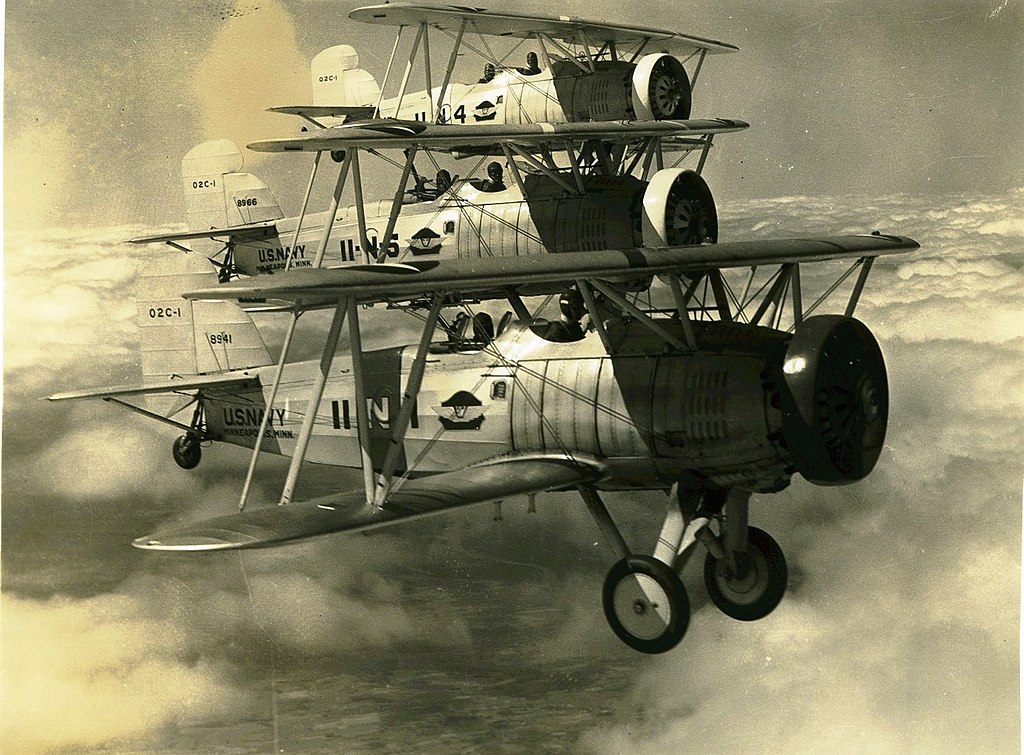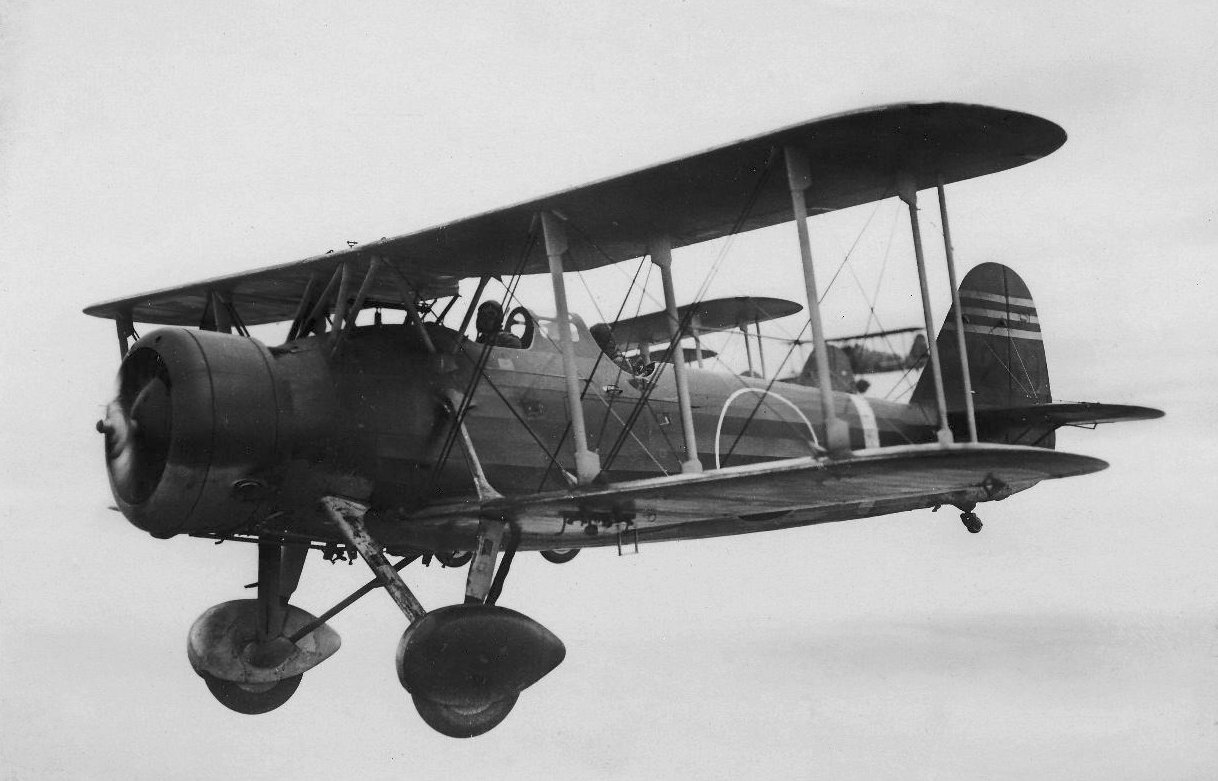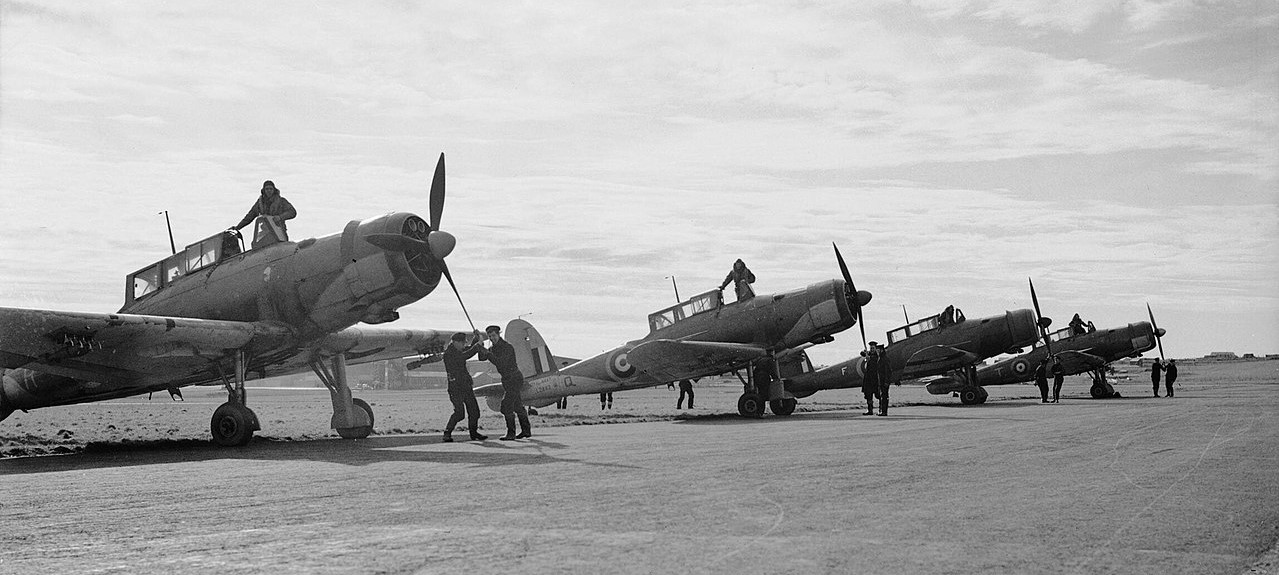Throughout WWII, the single most effective way of delivering high explosives to ships was dive bombing. This is exactly what it sounds like, the aircraft diving towards the target before releasing the bomb, then performing a high-G pullout to avoid following the bomb into the target. It was originally developed during WWI to attack land targets, as pilots realized that it allowed them to place bombs far more accurately,1 although the fragile aircraft of the time were limited to fairly shallow dives.2

Curtiss F8Cs, the first US dive bomber
Dive bombing nearly died off in the years immediately after WWI, abandoned in the enthusiasm of airpower advocates for level bombing, but it was adopted by the US Marines and Navy in the late 20s, using fighters equipped with light bombs for support in ground fighting. Initially, they used fairly shallow dives, but the target had a tendency to disappear under the nose of the aircraft, and it was soon realized that steeper dives not only solved this problem and improved accuracy, but also were far harder to defend against. The plunging dive bombers were generally difficult to see before they began their dives, and once in a dive, the rapid change in range meant that heavy AA guns were ineffective, while lighter AA weapons had only a narrow window to work against the diving aircraft.3 The basic technique they used would remain standard throughout the dive bomber's life: approach at 10,000' or so, then push over into a steep dive, 70° or more. As he dove, the pilot would aim at the target attempting to compensate for wind and the movement of the ship. The bomb would be dropped during the dive, and the pilot would then pull out and fly away at high speed and relatively low altitude. What altitude the pull-out was done at varied, with early tests taking place at 1000' or so, although later aircraft had to do so at greater altitude to avoid plowing into the ground.4 The pullout itself would often subject pilot and plane to 6G or more, enough to make the pilot's vision gray out, which generally limited the tactic to smaller aircraft.5

A bomb is loaded on an SBD, with trapeze visible
But as dives got steeper and bombs got bigger for anti-shipping use, a new problem appeared. Bombs, particularly bigger ones, tended to fall faster than an airplane in a dive, which meant that in a steep enough dive, the bomb, released from under the fuselage, would hit the propeller. The solution was "displacement gear" or the "trapeze", a device under the fuselage of the aircraft that would swing the bomb clear of the propeller before release. A second unique feature of the dive bomber came a few years later, as biplanes gave way to streamlined monoplanes and designers realized that the planes would be too fast in a dive for safety. The answer was dive brakes, flaps that would be deployed in the dive to add drag on the way down. These were first seen on the Northrop BT, which was soon developed by its legendary designer, Ed Heinemann, into the most famous dive bomber of all,6 the Douglas SBD Dauntless. Also in this era, the concept of dive bombing spread outside of the US, propelled both by foreign observers reporting on American exercises and the 1932 film Hell Divers, starring Clark Gable, which probably did at least as much to get other nations actually interested.

Japanese Aichi D1A2 dive bomber
But even as Japan and Britain joined the US in the adoption of the naval dive bomber, they were also encountering the limitations imposed by the technology of the day. To achieve reasonable performance, a dive bomber could carry no more than a 1,000 lb bomb, and when combined with the relatively low impact velocities of dive-bombing7 tended to sharply limit armor penetration. The US 1000 lb AP bomb would have to be released from 6500' in a 300 kt 60° dive to pierce a 5" deck, and at that altitude, accuracy wouldn't be great, and even doubling bomb weight (which also limited the bomb to Helldivers and Avengers) only dropped the minimum release altitude to 4500'.8 But 5" decks were only found on battleships, so this wasn't much of a problem when attacking the vast majority of warships. Dive-bombers were accurate enough to be effective against destroyers and a 1,000 lb bomb would be enough against most cruisers, to say nothing of the effect on lightly-armored carriers. But it did mean that sinking a battleship would require torpedoes, although navies quickly realized that dive bombers could be quite effective at disrupting the ship's air defenses to open the way for their slower brethren if the two types could coordinate their attack. Ultimately, wartime experience would show that this was easier said than done.

Skuas in the Orkneys
Further limiting payload and performance was the fact that everyone had settled on using their dive-bombers as scouts as well, which required a second crewman to serve as navigator and radio operator. In case of fighter attack, the dive bomber was generally equipped with a rear-firing machine gun, although in the late 30s, the threat of fighter interception was generally considered fairly minimal. Without radar, there were decent odds that the dive-bombers would be overhead before they were spotted, and even if they were spotted earlier, vectoring the fighters out to intercept in time would be difficult. The British took this view the furthest, deciding that the best protection they could provide their carriers was extensive deck armor that would allow them to survive dive-bombing attacks, and making plans to use their new dive-bomber, the Blackburn Skua, as their primary fighter, too.9 The Skua proved a fairly effective dive-bomber, sinking the German cruiser Konigsberg off Bergen, the first major warship sunk by air attack, but it was a failure as a fighter, and the British soon had to scrounge up single-seat fighters for their carriers.
But this only takes us through the outbreak of war, and we'll have to look at the wartime performance of the dive bomber next time.
1 This is essentially because the airplane is traveling much closer to the bomb's trajectory, which means that the effect of any error, particularly a timing error, is smaller. For instance, a B-17 at maximum speed will miss by 128 m for every second of timing error, while a plane flying along the bomb's trajectory towards the target can in theory drop at any time and still get a perfect hit. Obviously, that's not practical, but basically any dive is going to move the airplane closer to the bomb's trajectory, making it more forgiving of errors. ⇑
2 There is generally a distinction drawn between dive bombing, done at dive angles above 60-70° and glide bombing, done at lower angles. To a first approximation, the steeper dives generally required purpose-built aircraft with dive brakes, but this wasn't absolute. The exact boundaries of the categories are somewhat fuzzy. I intend to include basically all forms of diving bomb attack here. ⇑
3 A plane diving from 12,000' at 300 kts (not particularly fast for the 40s) gave the defenders only 20 seconds to shoot back. ⇑
4 It's surprisingly hard to find the numbers for later. As best I can tell, typical pullout altitude was between 1500' and 3000', although it could be lower if the pilot was willing to take risks. ⇑
5 Note the word "generally". True dive-bombing was almost entirely restricted to single-engine aircraft, while a few twin-engine aircraft, such as the Pe-2 and Ju 88, made extensive use of shallower, but still fairly steep, dives. Prewar, the Germans decided that the solution to poor accuracy from their level bombers was to give the heavy bomber they were developing, the four-engine He 177, the ability to dive bomb. Among other things, this meant that instead of giving each engine its own propeller, it would have two propellers, each driven by a pair of engines geared together, to limit drag in the dive. This worked very poorly, and the He 177 gained a reputation for inflight fires. Diving tests showed that even though it was limited to 60° dives, the stress of pullout was too much for the airframe, and tended to make the wings fall off. This, combined with improvements in German bombsights, meant that the dive brakes were omitted from most aircraft. As far as I know, none of this was for attacking ships, but it's an interesting story. ⇑
6 Except maybe the German Stuka, which never flew from a carrier, and hasn't had a major movie made about it recently. And yes, I do know about the plans to fly them off Graf Zeppelin, but that never actually happened. ⇑
7 Yes, the plane is diving at 300 mph or so, but the bomb's terminal velocity is a lot higher than that, as evidenced by the issues they had with the bomb hitting the propeller before the trapeze was introduced. ⇑
8 Several nations looked at using rocket-propelled bombs to solve this problem, but none were ever placed in service, although the Germans appear to have come closest. Related was the Disney bomb, a much larger rocket-propelled bomb intended for use against land targets like submarine pens, and named after that Disney, who inspired it through a clip in the film Victory Through Air Power. ⇑
9 This is slightly more explicable because for various reasons the British didn't believe in single-seat carrier aircraft. ⇑

Comments
Really? I would guess that if you asked random people to name a dive bomber, the most popular (correct) answer would be the Stuka...
On the grounds that we have no polling data and I don't feel bound to have any before I say things like that if I'm not actually wrong, I'm going to leave it as-is. (Sometimes, writing is hard, and using things like that makes it sound better.)
...Although it wasn't a naval aircraft (the manufacturer, however, had gotten the USN to assign TBV-1 for a proposed torpedo variant) the Vultee Vengeance, A-31/35 in US service, is unfairly forgotten since she was an afterthought here. The Australians and Indians, however, loved them - especially the fact that the Vengeance was actually capable of diving at 90 degrees, and with some practice they were brutally effective. Just one complete Vengeance survives in Australia.
https://en.wikipedia.org/wiki/VulteeA-31Vengeance
8 This is slightly more explicable because for various reasons the British didn’t believe in single-seat carrier aircraft.
Surely this needs to be expanded upon?
And another vote for the Stuka for me.
That probably deserves a full post at some point, but "history of carrier aviation" is a big topic, and I'm not likely to start it unless I get annoyed about something or otherwise sort of do it by accident. The short version is that they thought that all carrier aircraft needed a dedicated navigator, likely as a result of their general dedication to EMCON, which means you can't just turn on a radio beacon to call your planes home. (I think I read that after the post was written, which is why it isn't in there.)
The Stuka?
Weren't we talking about naval aviation?
The Ju 87C/E intended for the Graf Zeppelin were never used from a carrier, so they should not count as naval aviation...
IIRC the USN was (at least by doctrine) pretty tight-sphinctered on the subject of aids to navigation, carrier aviation, for the use of. I don't feel like looking it up right now, but my memory of the legends that Robert Heinlein built up around himself included turning on a radio beacon at a minimum without orders, possibly against orders, when he was a serving officer. (I'm pretty sure I'm gravely misremembering details), and even in WWII I recall it was somewhat controversial that the carriers turned on their lights after the Marianas (?) to guide the planes home...
The RN has always been considerably more careful about EMCON than the USN, dating back to before WWI. (Actually, on second thought, I'm less sure that's a complete explanation than I was, but I don't want to dig through a bunch of books right now.) The big issue with turning on the lights at Philippine Sea was that it potentially exposed them to direct submarine attack, which radio wouldn't do nearly as much because it's far less precise.
I'm sure the RN is undisputed champion there.
But I also consider blacking out the lights to be an EMCOM measure.
And now you've inspired me to dig out what's underneath my memory about RAH. He was a radio communications officer aboard USS Lexington (CV-2), at least
I found it. Author's commentary on Searchlight, in Explanded Universe (RAH). I am looking at an ebook edition (off one of the Baen Free CDs), so I can't easily pull a page reference.
I was wrong about the details, though - Heinlein says he was radio compass officer when VF-2 "got lost"; he could talk to the "plane guard" pilot. And it was the "Fleet C-on-C who cancelled war-condition darken-ship" and ordered searchlights turned on for the lost pilots to home on.
It's worth noting that when Heinlein was on Lexington, night operations were still in their infancy. In the 30s, most squadrons did night landings once a year, essentially to make sure they could get aboard safely if things went wrong, and even that didn't start until 1929.
Also worth noting that the RN wasn't entirely anti-emissions. They used a radio beacon at Taranto, for instance.
Heinlein notes that most of the pilots made their first night carrier landing right then. And only one of them bent their bird in the doing. (And that the plane-guard amphibian ran out of gas before coming to a stop on deck...)
Anyway, I had significantly misremembered the anecdote
Seeing the discussion in the adjacent post (Military Spaceflight 9), another remark to the effect of "surely the most famous dive bomber is the Stuka, partly on the grounds of being named effectively the same as the category".